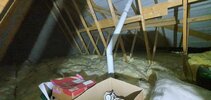I've read that the recommended weight limit for loft storage is 25kg per m2. I have seen some posts go up to 50kg. I imagine that there a lot of this is going to depend on the variation in house build quality.
I live in a new build , the loft is about 6m x 6m (pic attached) and the joists are about 34mm x 94mm and roughly 60cm apart (although that varies). Given that, I expect I'm towards the lower end of the storage recommendations.
I was thinking of boarding using loft legs and 18mm OSB boards. Problem is, 18mm OSB boards themselves weigh 11-14 kg per m2. Add to that the weight of the loft legs and I think that means I only have about 10-12kg per m2 of storage weight.
That makes me think the usefulness of loft storage is pretty limited. Have I missed something?


